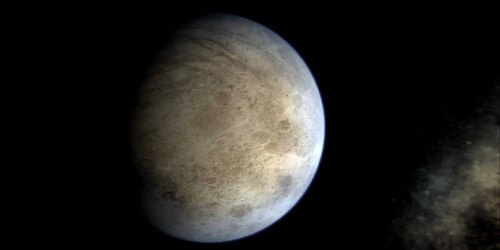Ceres is between the orbit of Mars and the orbit of Jupiter; It was discovered back in 1801, but it was only nine years ago that it was upgraded from "just" an asteroid to the status of a dwarf planet. In March, the Don research spacecraft arrived, which has already begun to transmit fascinating findings

Author: Dr. Netzah Parbiash, a young Galileo
Last March, NASA's Dawn (Hebrew: Shahar) spacecraft entered its orbit around the dwarf planet Ceres, after an eight-year journey. In the coming months, the spacecraft will circle Ceres and study its composition and surface structure.
Nice to meet you, Kers
Ceres is about 900 kilometers in diameter, and is the largest celestial object known to science in the asteroid belt that is between the planets Mars and Jupiter. Ceres' relatively large mass, which is about forty percent of the total mass of asteroids in this region of the solar system, contributed to its spherical shape. When the visibility is particularly good, it can even be viewed with the unaided eye, without a telescope or other magnifying device, due to its size compared to the other objects in the asteroid belt. However, despite its relative proximity to the Earth, it has not yet been studied closely.
Ceres (also called Ceres) is currently defined as a dwarf planet. It was discovered on January 1, 1801 by the Italian astronomer Giuseppe Piazzi. For years, scientists debated whether it was a planet or an asteroid, and only in 2006, at the International Astronomical Union (IAU) meeting held in Prague, it was decided to change its classification to a dwarf planet (and that of Pluto, which was considered a planet until then).
The story about the discovery of a hook
As often happens in science, Piazzi also discovered Keres by accident. He looked for another planet, but a mistake in the place in the sky he planned to look at caused him to focus on another area, where he spotted a very small planet-like object. At first Piazzi thought it was a comet. After many observations he decided to publish his discovery, and claimed that due to the slowness of Ceres' movement and due to its shape, there is a chance that it is more than a comet (comets are small and common heavenly bodies compared to the planets).
Piazzi continued his observations of Ceres for several months, until he disappeared (temporarily, of course) when he was hidden behind a solar halo. The paucity of mathematical tools that existed at that time did not allow an accurate prediction of the expected location of Ceres after leaving the sun's halo, and therefore Piazzi was unable to locate it again.
Carl Friedrich Gauss, one of the greatest mathematicians and scientists of all time who lived at that time, decided to try to solve the mystery. After three months of work, Gauss presented a mathematical theory that makes it possible to predict the location of a celestial body even based on relatively little data. Gauss calculated the orbit of Kress while using his new mathematical method, and sent the result to Baron Franz von Sachs, who was the editor of a famous scientific journal. On December 31, 1801, von Sachs published his (re)discovery of a hook.
And the forecast: surprising temperatures
The arrival of the Don spacecraft into orbit around Keres is particularly important because the data accumulated so far about it are relatively few. It is interesting and surprising that during the day a temperature of minus 34 degrees Celsius was measured on the face of Kers. It sounds like extremely cold, but for a celestial body that is at such a great distance from the sun, this is a higher than expected temperature, and therefore very surprising. A possible explanation for such a high temperature could be related to heat-emitting sources that are located under the ground of Keres. Heat may be escaping from the dwarf planet's groundmass through cracks in it, similar to those found at the south pole of Saturn's moon Enceladus.
In ultraviolet observations in 1995, the researchers noticed a spot that was about 250 kilometers in diameter (the spot was named "Piazzi", in honor of the man who discovered Ceres). At the time it was thought to be a crater, but in later observations, which were made with more sophisticated equipment, the spot was not seen. On the other hand, two other spots were located which are in motion with a hook (rotating around itself) and were identified as craters. Already, from the first photos that Don sent, you can clearly see many craters on Keres' face, and even spots that may indicate that there are changes in his surface.
In the coming months and years to come, we will surely hear about new and fascinating discoveries, which will be provided by the data that Don will send us from the face of the relatively close celestial sphere, which has not yet been studied in depth. Get ready for exciting news!
* The author is a Scientific Vice President at the Carso Science Park in Be'er Sheva, www.sci-park.co.il
The article appeared in the May issue of Young Galileo – Monthly for curious children
Want to read more? To receive a young Galileo magazine as a gift
